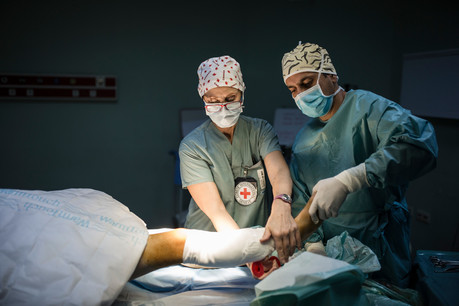Please visit our COVID-19 resource page for the most current information about Red Cross programs, support, and tips.
While Canada and the rest of the world grapple with the current public health crisis, COVID-19 is one additional danger to people living in conflict-affected parts of the world. Threats like traumatic injuries from bombs and bullets, as well as weakened health care systems that have been attacked or destroyed in the fighting.
 Things many of us take for granted, like basic hygiene, are not guaranteed for people living in situations of conflict. Soap and clean water are a luxury for many, making it difficult for individuals to protect themselves from the spread of disease. Detention facilities in war zones are often overcrowded and are particularly susceptible to outbreaks and diseases, including COVID-19. People living in displacement camps are also especially vulnerable to overcrowding, lack of ventilation and inadequate sanitation supplies. Physical distancing is simply not possible for those living in refugee or displaced persons camps.
Things many of us take for granted, like basic hygiene, are not guaranteed for people living in situations of conflict. Soap and clean water are a luxury for many, making it difficult for individuals to protect themselves from the spread of disease. Detention facilities in war zones are often overcrowded and are particularly susceptible to outbreaks and diseases, including COVID-19. People living in displacement camps are also especially vulnerable to overcrowding, lack of ventilation and inadequate sanitation supplies. Physical distancing is simply not possible for those living in refugee or displaced persons camps.Health cares systems around the world are being stretched thin by the needs arising from the global pandemic—even in countries with strong public health systems and no wars. Hospitals in war zones are already facing overwhelming needs from the communities they serve, and in some cases, are under attack. With the additional needs of a population affected by COVID-19, health care systems in areas affected by conflict will not be able to respond adequately.
International Humanitarian Law (IHL), the rules that limit and prevent human suffering in times of armed conflict, provide important protections for people affected by war. These rules become especially important when faced with a global pandemic like COVID-19.
Under IHL, there are special protections in place to safeguard medical facilities and healthcare workers. In addition, parties to a conflict have the responsibility to ensure that the population under its control have access to medical services and basic needs are met. Impartial humanitarian organisations such as members of the Red Cross and Red Crescent Movement are able to offer their services, which may include the setting up hospitals or clinics to treat those affected by COVID-19 and parties to conflict must allow humanitarian assistance to reach those in need.
Refugees and internally displaced persons are especially at risk of the effects of COVID-19 due to harsh living conditions, dangerous travel, and lack of basic services, including sanitation. Under the rules of IHL, displaced populations must be provided with shelter, food, water, healthcare, and hygiene.
Detainees are also protected under IHL and their health and safety needs must be met. This means that detainees who have contracted the virus should receive treatment, and efforts must be made to prevent its spread, including through the provision of hygiene supplies and other measures.
Parties to a conflict have the responsibility to respect IHL at all times, however, with the additional threat of the pandemic, these rules are all the more essential. Following the rules of IHL will help reduce human suffering during the global pandemic. It is crucial that protections for civilians, including those displaced by war, are upheld and health care is protected by those involved in the fighting.
Related:
How does International Humanitarian Law protect women during war?
In war-torn countries, the Red Cross provides life-saving surgery
International Humanitarian Law: Protecting healthcare

